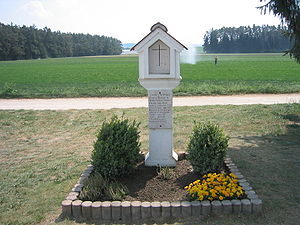Hinterkaifeck murders
From Wikipedia, the free encyclopedia
corresponding article in German.
(April 2015) Click [show] for important translation instructions.
Hinterkaifeck

Hinterkaifeck five days after the attack
Location Modern-day
Waidhofen, Bavaria,
Germany
Date 31 March 1922
Target Gruber family
Attack type
Home invasion,
mass murder
Weapons Mattock
Deaths 6
Perpetrators unknown

Shrine near site of former farmstead
Hinterkaifeck was a small farmstead situated between the Bavarian towns of
Ingolstadt and
Schrobenhausen, approximately 70 kilometres (43 mi) north of
Munich. On the evening of 31 March 1922, the six inhabitants of the farm were killed with a
mattock. The murders remain unsolved.
The six victims were parents Andreas Gruber (63) and Cäzilia (72); their widowed daughter Viktoria Gabriel (35); Viktoria's children, Cäzilia (7) and Josef (2); and the maid, Maria Baumgartner (44).
Hinterkaifeck was never an official place name. The name was used for the remote farmstead of the hamlet of Kaifeck, located nearly 1 kilometre (0.62 mi) north of the main part of Kaifeck and hidden in the woods (the prefix
Hinter, part of many German place names, means
behind), part of the town of Wangen, which was incorporated into
Waidhofen in 1971.
Contents
[
1Crime
Crime[edit]

This section
does not cite any sources. Please help
improve this section by
adding citations to reliable sources. Unsourced material may be challenged and
removed.
(October 2012) (Learn how and when to remove this template message)
A few days prior to the crime, farmer Andreas Gruber told neighbours about discovering footprints in the snow leading from the edge of the forest to the farm, but none leading back. He also spoke about hearing footsteps in the attic and finding an unfamiliar newspaper on the farm. Furthermore, the house keys went missing several days before the murders. None of this was reported to the police prior to the attack.
Six months earlier, the previous maid had left the farm, claiming that it was haunted; the new maid, Maria Baumgartner, arrived on the farm on the day of the attack and was killed hours later.
Exactly what happened on that Friday evening cannot be said for certain. It is believed that the older couple, as well as their daughter Viktoria, and her daughter, Cäzilia, were all lured into the barn one by one, where they were killed. The perpetrator(s) then went into the house where they killed two‑year‑old Josef, who was sleeping in his cot in his mother's bedroom, as well as the maid, Maria Baumgartner, in her bedchamber.
On the following Tuesday, 4 April, neighbours came to the farmstead because none of its inhabitants had been seen for a few days. The postman had noticed that the post from the previous Saturday was still where he had left it. Furthermore, young Cäzilia had neither turned up for school on Monday, nor had she been there on Saturday.
Investigation[edit]
Inspector Georg Reingruber and his colleagues from the Munich Police Department investigated the killings. More than 100 suspects have been questioned throughout the years, with the most recent questioning taking place in 1986. None of the questioning yielded any results.
The day after the discovery of the bodies, court physician Johann Baptist Aumüller performed the
autopsies in the barn. It was established that a
mattock was the most likely murder weapon. Evidence showed that the younger Cäzilia had been alive for several hours after the assault – she had torn her hair out in tufts while lying in the straw, next to the bodies of her grandparents and her mother. The skulls of the corpses were sent to Munich, where
clairvoyants examined them, to no avail.
[1] The heads were later lost, possibly destroyed in the
Allied bombings in World War II.
The police first suspected the motive to be robbery, and they interrogated traveling craftsmen, vagrants, and several inhabitants from the surrounding villages. This theory was abandoned when a large amount of money was found in the house. It is believed that the perpetrator(s) remained at the farm for several days – someone had fed the cattle and eaten food in the kitchen, and the neighbours saw smoke from the chimney during the weekend – and would have easily found the money if robbery had been the intention.
The death of Karl Gabriel, Viktoria's husband (who had been reported killed in the French trenches in
World War I), was called into question. His body had never been found. However, most of his fellow soldiers reported seeing him die, and the police believed their reports.
Two-year-old Josef was rumoured to be the son of Viktoria and her father Andreas, who had an
incestuous relationship that was documented in court and known in the village.
[2] A neighbouring farmer named Lorenz Schlittenbauer publicly claimed to be Josef's father, and paid alimony to Viktoria and Andreas. Shortly before the murders, Viktoria was preparing to sue Schlittenbauer, who by then had a wife and a baby, for alimony. Schlittenbauer was part of the original search party that found the corpses, and he disturbed the bodies before the police arrived. The police questioned Schlittenbauer extensively but were unable to find concrete evidence linking him to the crime.[
citation needed]
In 2007, the students of the Polizeifachhochschule (Police Academy) in Fürstenfeldbruck examined the case using modern criminal investigation techniques. They concluded that it is impossible to definitively solve the crime after so much time had passed. The primitive investigation techniques available at the time of the murders yielded little evidence, and in the decades since the murders, evidence has been lost and suspects have since died. Despite these setbacks, the students did establish a prime suspect, but did not name the suspect out of respect for still‑living relatives.
Aftermath[edit]
The six victims are buried in Waidhofen, where there is a memorial in the graveyard. The skulls were never returned from Munich, after having been lost during the chaos of
World War II.
The farm was demolished a year after the attacks, in 1923. Close to where the farm was located, there is now a shrine.
In popular culture[edit]
There are two films with the name
Hinterkaifeck: one by Hans Fegert from 1981, and one by Kurt K. Hieber in 1991.
Hinter Kaifeck is a mystery thriller from 2009 made by director Esther Gronenborn and producer Monika Raebel, starring
Benno Fürmann and
Alexandra Maria Lara.
[3]
In 2006, German writer
Andrea Maria Schenkel wrote a novel entitled
Tannöd where she tells the story of Hinterkaifeck using different names for the locations and people involved. Also the novel
The Murdered House, written by French writer Pierre Magnan, is allegedly inspired by this case. In this novel, the youngest victim of the massacre survives and returns to the farm as an adult to investigate the crime.
Munich journalist Peter Leuschner wrote two books with the title
Hinterkaifeck: Der Mordfall. Spuren eines mysteriösen Verbrechens. in 1979 and 1997. The second book is an extension of the first book. The title means
Hinterkaifeck. The Murder Case. Traces of a mysterious crime. In this book, Leuschner quotes the original police files.
In October 2015, popular podcast
Stuff You Missed in History Class covered the HinterKaifeck murders.
In 2016, popular podcast
Stuff You Should Know did a show on the events that occurred for their pre-Halloween special.
In 2016,
Buzzfeed's
Unsolved: True Crime covered the case, discussing possible theories of who did it.
In 2017, in episode 60 of the podcast
My Favorite Murder,
Karen Kilgariff mentioned the Hinterkaifeck murders during a segment on
The Axeman of New Orleans.
In 2017, the last chapter of
The Man from the Train, briefly discusses the murders at Hinterkaifeck and the possibility that they might have been committed by the titular serial killer. The authors rate the chances as "more or less a toss-up" but conclude "there's no real reason to believe that it's not him."
[4]
In January 2018,
Steep Theatre in Chicago premiered the play Hinter
[5] by Calamity West based on the Hinterkaifeck Murders
References[edit]
- Jump up^ Leuschner, Peter (1997): Hinterkaifeck. Spuren eines mysteriösen Verbrechens. p. 76 ff.
- Jump up^ "Inzestuöse Beziehung Viktoria Gabriel / Andreas Gruber". Der Mordfall Hinterkaifeck. Retrieved 4 January 2012.
- Jump up^ Hinter Kaifeck (2009) on IMDb
- Jump up^ 1949-, James, Bill,. The man from the train : the solving of a century-old serial killer mystery. James, Rachel McCarthy, (First Scribner hardcover ed.). New York. ISBN 9781476796253. OCLC 962016034.
- Jump up^ http://steeptheatre.com/hinter
Bibliography[edit]
- Guido Golla (2016). Hinterkaifeck: Autopsie eines Sechsfachmordes. Norderstedt 2016, ISBN 978-3-741239-53-3.
External links[edit]
Coordinates:
48°35′40″N 11°19′20″E
Authority control
Categories:
Navigation menu
Search
Interaction
Tools
Print/export
Languages
Edit links
 Welcome to the Muppet Central Forum!
Welcome to the Muppet Central Forum!
.jpg) Christmas Music
Christmas Music
 Macy's Thanksgiving Parade
Macy's Thanksgiving Parade
 Sesame Street debuts on Netflix
Sesame Street debuts on Netflix
 Back to the Rock Season 2
Back to the Rock Season 2
 Sam and Friends Book
Sam and Friends Book
 Jim Henson Idea Man
Jim Henson Idea Man
 Bear arrives on Disney+
Bear arrives on Disney+





